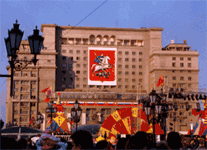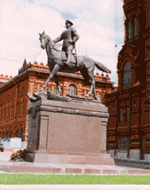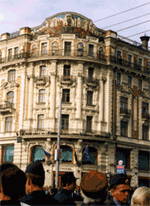Everbrite's Russia, Belarus and Ukraine Pages
Belarus
Belarus Info
Russia
Russia General Info
Russian Consulate Information
Obtaining a Russian Visa
Money and Other Tips
Tidbits for Tourists:
A to I
K to Z
Rulers of Russia:
From the Beginning to the Time of Troubles
From the Romanovs to Revolution
From Soviet Times to the present
Russia Regional Information:
Moscow
Petersburg
Irkutsk/Lake Baikal
Kaliningrad
Karelia
Tuva
Valdivostok
Moscow Metro Tour
Central Moscow Tour- in four parts with map:
Part 1 Stops 1 through 13. Marriott Royal/Hotel Budapest to Manezh Ploshchad
Part 2 Stops 14 though 22. Around Manezh Ploshchad
Part 3 Stops 23 though 44. Along Tverskaya Street to the area around Puskin Square
Part 4 Stops 45 though 48. From Puskinskaya Ploshchad to Upper St. Peter's Monastery and back
MAP
Travel in Russia planes, trains and automobiles
Trans-Siberian Trains information to get you started on your journey
Stops along the Trans-Siberian Route places to stop along the way
Russian Language and Culture
The Alphabet
Books, Tapes and other Resources
Basic Words
Superstitions
Ukraine
Ukraine Info
|
|
Central Moscow Tour - part two
Around Manezh Ploshchad
This tour starts in Manezh Ploshchad, facing the Hotel Moskva.
Hotel Moskva - Moscow's 850th Birthday

Stop number 14
This is the Hotel Moskva designed by Aleksei Shchusev (1873-1949), Leonid Savelyev and Osvald Stapran between 1932 and 1935. Intended to demonstrate that Soviet design and technology could produce a hotel of international standards, the facade of the Moskva was a combination of different design elements. Legend has it that the architects designed two alternate facades to be presented to Stalin who signed his name across both pages. Afraid to ask for clarification, the Hotels main facade on Manezh Square was built asymmetrically with the top left differing from the right. Note that one side has fifteen stories and a huge portico, while the section facing Okhotny Ryad has ten stories and two tower-like projections.
When first opened, the details of the interior ornamentation and the room furnishings were quite lavish, but over time the place became just another Soviet-style hotel, serving as home away from home for visiting Communist Party Deputies and Officials from the provinces. Its drab interior and large open first floor are uninteresting, although some upper rooms have been renovated and have a great view of Red Square and the Kremlin Walls. (Tel.: 960 20 20) (2 Okhotny Ryad)
Walk toward the entrance to Red Square. Look beyond the end of the Hotel, to the left.
Stop number 15
Between the Hotel Moskva and the Resurrection Gate (an entrance to Red Square) is a unique little museum, the Moscow Museum of Archeology, that is affiliated with the Museum of Moscow History. Its exhibits include fragments of the Voskresensky (Resurrection) bridge, archeological finds from Manezh Square, Moiseevsky Monastery, Gostiny Dvor and other archeological materials and photos. There is a permanent exposition called "Objects of Archeological Digs in the Historical Center of Moscow" plus temporary exhibits. Unfortunately it is mostly in Russian. (1a Manezh Square) (Open daily except Mon. 10 a.m. 6 p.m., Wed. and Fri. 11 a.m. - 7 p.m. Tel.: 292 41 71)
Continue towards the Resurrection gate entrance to Red Square look ing down at the granite paving stones.
Stop number 16
Some years ago the Moscow City government decided that since all roads lead to Red Square, there should be an official point from which to measure. A Bronze Signpost in the form of a circle six meters in diameter was set in the pavement. Inside is a square corresponding to the four points of the compass. Each side of the square is three meters long. The flora and fauna of the different regions of the Soviet Union are represented on it. The north side is illustrated by reliefs of a Polar owl, a reindeer, a seal and a cloudberry. Opposite it, to the south are pictures of a mountain goat, a vulture, a dolphin and a mandarin orange. Symbolizing the west are black grouses, a bison, an eel and an oak tree. The east is depicted by an Ussuri tiger, a Central Asian cobra, a Siberian cedar and a bird. In the middle of the square is a polished disk whose very center is the point from which distances are measured.
Back to top
Look up from the ground.
Resurrection Gate

Stop number 17
Rebuilt in 1994, the Iberian Resurrection Gate is an "exact" copy of an ancient entry way. The original entrance had been completed in 1534 and was part of the Kitai Gorod walls. In 1680, a new entrance was built with the addition of a Chapel of the Iberian Mother of God. Initially this gateway led to the Resurrection Bridge over the Neglinnaya River before it was tunneled underground after the 1812 fire. It was traditional for Russians to visit this chapel before going on a journey or conducting important business. Whenever the tsar visited Moscow, it was customary to pray here prior to entering the Kremlin and again before departing from the city.
Stalin ordered the gateway torn down in 1931 to permit mass parades of people and weaponry to enter Red Square. The red brick gates, twin towers and blue and green chapel were rebuilt in 1994-1995. Note the mosaic icons on the gate; one represents Moscow's patron saint, St. George, slaying a dragon.
Turn to the right.
Stop number 18
This symmetric building with exposed red brick, tent-like towers, porches and silver roof is the State History Museum. Constructed in 1874 by Vladimir Shervud (1833-1897), the building was designed to evoke the memory of various Russian styles that preceded it. As part of the restoration work, the spires are again topped by gilded double eagles reminiscent of the tsars' times. Supported by private donations when it opened in 1883, the museum contained over 300,000 objects. Today it has over four million items, including the largest collection of artifacts tracing the history of Russia from the Stone Age until today. When the building reopened in 1997 only a few rooms were finished, each representing a different period or region. Renovations, however, continue and more rooms will be on display. In 2001 only 15 of 45 rooms were open to the public and five of those are used for temporary exhibitions. The ticket office is reached by going through the Resurrection Gate, then to the right after the entrance. Further into the building and down the stairs on the left are the coat rooms and bathrooms. While the videos in the lobby are multilingual, the captions for the exhibitions are only in Russian. To reach the main exhibition, take the staircase in the great hall which used to be the ceremonial stairway to Red Square. A family tree of the Russian monarchs dating back to Vladimir and Olga of Kiev decorates the ceiling.
A restaurant called One Red Square is located within the museum to the left after the entrance. It offers historic menus and meals from different periods of Russian history based on recipes and menus from within the museum's collections. And there are several excellent gift shops which can be entered without visiting the museum. (Museum Hours: Open daily except Tues. and the first Mon. of each month 11 a.m. - 7 p.m. Tel.: 228 84 52.)
Back to top
Look at the statue in front of the History Museum.
Marshall Gregory Zhukov

Stop number 19
Sitting atop his horse is Marshall Gregory Zhukov (1896-1974), a World War II hero whose ashes are buried in the Kremlin Wall. Zhukov led the Russian Army in the defense of Moscow and later the defense of Stalingrad. For this he was appointed Marshal of the Soviet Union and Deputy Supreme Commander of the Army. He either planned or commanded most of the great victories that pushed the German Armies back to Berlin where he served as the Soviet Representative at the official German surrender. The statue was placed here to celebrate the 50th anniversary of the victory over Germany and the 100th anniversary of Zhukov's birth on December 1, 1996. He is shown here as he looked for the Red Square Victory Parade of 1945 when his horse trampled Nazi battle standards.
Turn around and face the square.
Stop number 20
Partially underground, the Okhotny Ryad or Manezh Underground Shopping Mall can be entered from the metro without ever venturing into the sunlight. Note that there is a food court on the lower level; nearby as well as are reasonably clean bathrooms for a fee. Until 1938 the area was filled with many old buildings, but these were razed in a plan for a superhighway that was never built. In 1967, the area was renamed "50th Anniversary of the October Revolution Square." In the early 1990s the original name of Manezh Square returned. About the same time, Mayor Yuri Luzhkov (1936- ) drew up plans for the Okhotny Ryad or Manezh Underground Shopping Mall. Construction had to be halted in 1993 to let archaeologists explore the area, but the mall opened in 1997 in time for the 850th anniversary of the founding of Moscow. It is filled with high-priced boutiques, outdoor cafes and empty storefronts. Outside the mall is a network of sculptures, mosaic tiled pools, balustrades and fountains, designed by Zurab Tsereteli (1934- ), which reportedly use water channeled from the underground Neglinnaya River. If not actually the river, at least it serves to recall the river. Many of the sculptures are based on Russian fairy tales and stories by Aleksandr Pushkin (1799-1837.) (Open daily 11 a.m. - 10 p.m.)
Back to top
Either walk through the mall or take a pedestrian underpass to the other side of Okhotny Ryad, which here changes its name to Mokhovaya Street (Moss-grown) Street.
The street takes its name from the word for moss (mokh) that was dried and sold from stalls located along here. Moss was used to caulk the cracks between the timbers from which wooden houses were built.ŠLater is was used between two panes of glass to keep them from fogging up.
The street at right angles to Okhotny Ryad and Mokhovaya is Tverskaya Street. Tverskaya Ulitsa has been a major thoroughfare from the Kremlin, first to Tver and later to St. Petersburg. Always a prominent trade route, it was also the path of royal processions from the new capital in the north to the Kremlin. During the 19th century it became a commercial center and was the first street to be lit by lampposts and covered by billboards. During the reconstruction of the city in the 1930s, the road was straightened and widened by forty-two meters. Many old buildings were torn down, while some were rebuilt in line with the new street. At the same time the street's name was changed to Gorky after Maksim Gorky (1868-1936), the "Father of Soviet Literature" author and early supporter of the Socialist Revolution. In 1990 the street again became Tverskaya Ulitsa.
Hotel Natsional - Moscow's 850th Birthday

Stop number 21
On the northwest corner of Tverskaya Street stands the National Hotel, an eclectic mixture of Classical and Style-Moderne architecture designed by Aleksandr Ivanov in 1903. Back then, this was the place to stay if money were no object, and since recent renovations, it again deserves that reputation. Outside the facade is decorated with nymphs and ornate stonework. There is also a Soviet era historic mosaic above the corner featuring "Progress" as depicted by factory chimneys, electric towers, oil derricks, train engines and tractors. Its worth looking inside to see the great marble staircase with its pewter vine leading upward and some other ornamental details that have been carefully restored. After the Soviet government moved to Moscow, Lenin and his wife and sister lived and worked here in Room 107 for about nine days. Despite the brief stay, a bronze plaque commemorates his sojourn here. (Tel.: 258 70 00) (15/1 Mokhovaya Sreet)
Before starting down Tverskaya Street look to the left of the National Hotel.
number 22
The pale yellow building next to the hotel on Okhotny Ryad is the Intourist Office, the official tourist agency that used to control the visits of all tourists from countries outside the U.S.S.R. sphere of influence. Constructed in 1933 as an apartment building, its style represents a transition in style from Constructivist to Stalin ornate. The Constructivist style of architecture is notable for its use of glass and reinforced concrete to create geometrical designs, while Stalin ornate employed many neo-classical features on a grandiose scale. The architect Ivan Zholtovsky (1867-1959), a Stalin favorite involved in Moscow's reconstruction from 1918-1924, consistently favored more traditional designs. Until 1950, the United States Embassy was located here. (13 Mokhovaya Street)
To continue walk up Tverskaya Street.
Back to top
End of Part Two. To continue take Part Three.
Part 1 Stops 1 through 13. Marriott Royal/Hotel Budapest to Manezh Ploshchad
Part 2 Stops 14 though 22. Around Manezh Ploshchad
Part 3 Stops 23 though 44. Along Tverskaya Street to the area around Puskin Square
Part 4 Stops 45 though 48. From Puskinskaya Ploshchad to Upper St. Peter's Monastery and back
MAP
Back to top
|




![]()